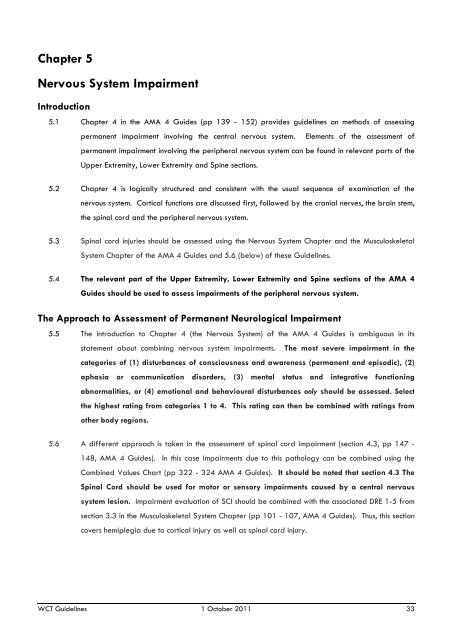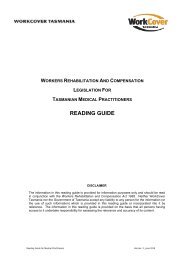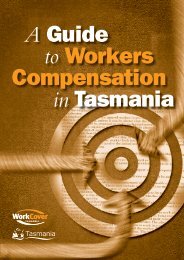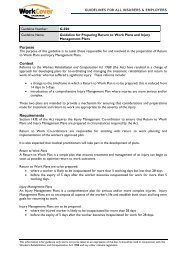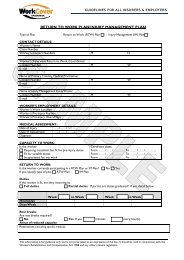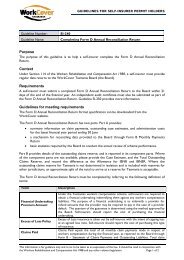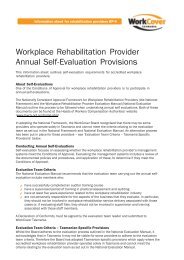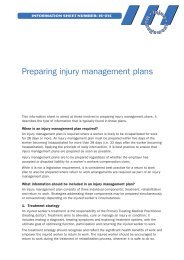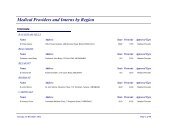Guidelines for the assessment of permanent impairment Version 3
Guidelines for the assessment of permanent impairment Version 3
Guidelines for the assessment of permanent impairment Version 3
You also want an ePaper? Increase the reach of your titles
YUMPU automatically turns print PDFs into web optimized ePapers that Google loves.
Chapter 5Nervous System ImpairmentIntroduction5.1 Chapter 4 in <strong>the</strong> AMA 4 Guides (pp 139 - 152) provides guidelines on methods <strong>of</strong> assessing<strong>permanent</strong> <strong>impairment</strong> involving <strong>the</strong> central nervous system. Elements <strong>of</strong> <strong>the</strong> <strong>assessment</strong> <strong>of</strong><strong>permanent</strong> <strong>impairment</strong> involving <strong>the</strong> peripheral nervous system can be found in relevant parts <strong>of</strong> <strong>the</strong>Upper Extremity, Lower Extremity and Spine sections.5.2 Chapter 4 is logically structured and consistent with <strong>the</strong> usual sequence <strong>of</strong> examination <strong>of</strong> <strong>the</strong>nervous system. Cortical functions are discussed first, followed by <strong>the</strong> cranial nerves, <strong>the</strong> brain stem,<strong>the</strong> spinal cord and <strong>the</strong> peripheral nervous system.5.3 Spinal cord injuries should be assessed using <strong>the</strong> Nervous System Chapter and <strong>the</strong> MusculoskeletalSystem Chapter <strong>of</strong> <strong>the</strong> AMA 4 Guides and 5.6 (below) <strong>of</strong> <strong>the</strong>se <strong>Guidelines</strong>.5.4 The relevant part <strong>of</strong> <strong>the</strong> Upper Extremity, Lower Extremity and Spine sections <strong>of</strong> <strong>the</strong> AMA 4Guides should be used to assess <strong>impairment</strong>s <strong>of</strong> <strong>the</strong> peripheral nervous system.The Approach to Assessment <strong>of</strong> Permanent Neurological Impairment5.5 The introduction to Chapter 4 (<strong>the</strong> Nervous System) <strong>of</strong> <strong>the</strong> AMA 4 Guides is ambiguous in itsstatement about combining nervous system <strong>impairment</strong>s. The most severe <strong>impairment</strong> in <strong>the</strong>categories <strong>of</strong> (1) disturbances <strong>of</strong> consciousness and awareness (<strong>permanent</strong> and episodic), (2)aphasia or communication disorders, (3) mental status and integrative functioningabnormalities, or (4) emotional and behavioural disturbances only should be assessed. Select<strong>the</strong> highest rating from categories 1 to 4. This rating can <strong>the</strong>n be combined with ratings fromo<strong>the</strong>r body regions.5.6 A different approach is taken in <strong>the</strong> <strong>assessment</strong> <strong>of</strong> spinal cord <strong>impairment</strong> (section 4.3, pp 147 -148, AMA 4 Guides). In this case <strong>impairment</strong>s due to this pathology can be combined using <strong>the</strong>Combined Values Chart (pp 322 - 324 AMA 4 Guides). It should be noted that section 4.3 TheSpinal Cord should be used <strong>for</strong> motor or sensory <strong>impairment</strong>s caused by a central nervoussystem lesion. Impairment evaluation <strong>of</strong> SCI should be combined with <strong>the</strong> associated DRE 1-5 fromsection 3.3 in <strong>the</strong> Musculoskeletal System Chapter (pp 101 - 107, AMA 4 Guides). Thus, this sectioncovers hemiplegia due to cortical injury as well as spinal cord injury.WCT <strong>Guidelines</strong> 1 October 2011 33


